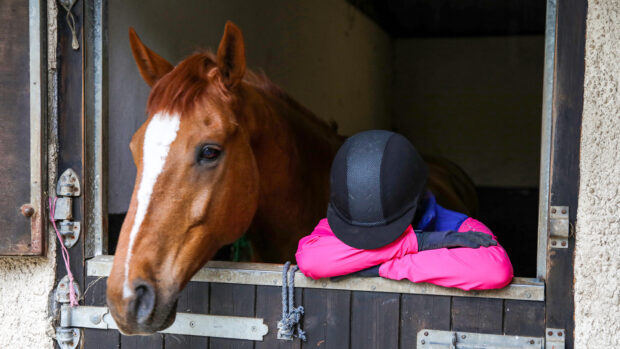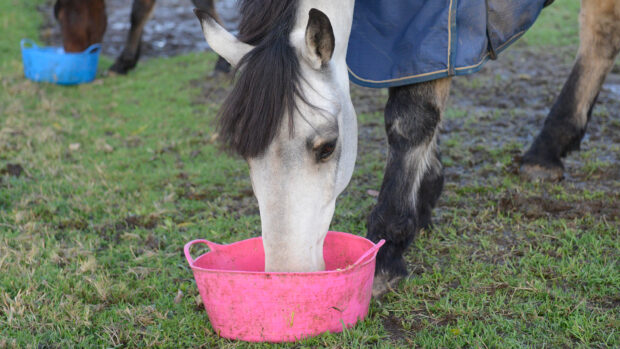Non-heating mix
Why choose it?
If excitability is part of a horse’s character you’ll never eliminate it entirely, but excess energy as a result of feeding can be regulated.
“Cool mixes” address the need to provide the necessary nutrients for a working horse, while keeping down the excitability levels sometimes produced by a hard feed, primarily caused by the starch content.
If hard feed affects your horse, then it is better to feed a nut than a mix, as cubes contain less starch than their mix equivalent.
Typical content
As the starch in grain causes excitability, a non-heating mix aims to provide energy in a less volatile form, by using higher levels of fibre and fat.
Typically, you might find more fibre in the form of grass pellets, alfalfa, vegetable oils, and lower levels of pulses and grain such as barley, maize and oats.
The traditional view is that oats cause excitability, but in fact, they have a lower digestible energy content and are high in fibre compared to other cereals. Cooking cereals breaks down starch, and helps them promote weight gain, useful in excitable horses inclined to lose condition.
Examples
- Spillers Cool Mix
- Badminton Coarse Cool Mix
- Dodson & Horrell Pasture Mix
- Winergy Calm
- Saracen Cooling Mix plus Herbs
- Allen & Page Quiet Mix
- Baileys No 13 Oat Free
- Balanced’ Horse Feeds Oatless Mix
- Dengie Alfa-Easy
Leisure mix
Why choose it?
Horses with a light workload may need a supply of nutrients in addition to grass and hay.
Leisure mixes are useful in these cases, and also as a base ration in yards where a number of horses with different requirements need to be fed easily.
Additional supplementation or other feeds can be added as required. Surveys show that many horses are receiving too much energy (ie hard feed) for the level of work they are doing. Leisure mixes can avoid this, while providing the necessary nutrients.
Typical content
These feeds provide a basic but minimal ration of grains such as barley and oats, with grass pellets or chaff for fibre, wheatfeed pellets for low energy bulk, and molasses to bind the ingredients and add palatability.
It’s important that even a low-energy mix has a full specification of vitamins and minerals included (often in pellet form). Be aware that if you’re using a budget feed, it may contain lower levels of the more expensive vitamins to allow manufacturers to keep costs down.
Try comparing the ingredients listed on the bags of different brands to avoid getting caught out.
These feeds provide a basic but minimal ration of grains such as barley and oats, with grass pellets or chaff for fibre, wheatfeed pellets for low energy bulk, and molasses to bind the ingredients and add palatability.
Examples
- Spillers Horse and Pony Herbal Mix,
- D&H Leisure Mix
- Allen & Page Hacking Mix
- Badminton Park Herbal
- Baileys No 9 All-Rounder
- Dengie Alfa-Easy
- Natural Horse Food Company Original
Competition mix
Why choose it?
If your horse works hard he will need all the energy he can get. Most performance mixes rely on high levels of starch, which is a fast-releasing energy source.
The downside is that if high levels of starch are fed, undigested material can force through the small intestine and reach the hindgut with severe consequences, such ascolic.
Remember to check that the feed is guaranteed for use in competition and is therefore free of banned substances.
Typical content
Grains such as oats, barley and maize provide the starch content in these mixes. Peas and beans provide protein and additional energy, and syrup or molasses bind the mix.
Manufacturers aim to maintain energy levels by increasing oil and digestible fibre to counteract problems associated with starch.
Oil is digested in the small intestine and will ‘spare’ starch as an energy source, while fibre is digested in the hindgut and will also act as a water reservoir, so reducing dehydration.
Competition mixes also have higher-than-average levels of vitamins and minerals, and perhaps also a probiotic or yeast.
Examples
- Spillers HDF Sports Mix
- Dodson and Horrell Competition Country Mix,
- Allen & Page Competition Extra
- Winergy Advanced
- Badminton Hi-Profile Competition Mix
- Saracen Sports Horse Mix
- Baileys No 6 Performance Mix,
- Dengie Alfa-Extra
- Natural Horse Food Company Resolve
Conditioning mix
Why choose it?
Like some humans, there are horses that do not put on weight easily. This can be due to breed, age, temperament, metabolism or workload, or maybe pain, poor teeth, illness or a cold,damp environment.
Before choosing a feed to increase your horse’s weight, you should check you have eliminated all these factors.
Another reason for choosing to feed this type of mix could be to add condition for the showring.
Typical content
These feeds contain mostly slow-releasing energy sources to keep the horse calm while maintaining weight, so they are based on high-quality fibre and oil.
The oil in particular gives a good shine to the coat as well as maintaining weight. Full-fat soya is especially good, being high in both protein and oil.
Grains will probably be cooked to maximise the weight gain, so expect to see cooked, flaked or micronised barley in particular, since it is a more highly digestible energy source than oats.
Examples
- Dodson and Horrell Build Up
- Baileys No.17 Top Line Conditioning Mix,
- Badminton Show and Conditioning Mix
- Saracen Show Ring Mix
- Balanced’ Show Mix
- Allen & Page Calm and Condition
- Spillers Conditioning and Showing Mix
- Dengie Alfa-Extra
- Triple Crown Triple Top-up
Veteran mix
Why choose it?
Older horses often do not keep condition easily, and they digest and utilize protein less efficiently.
A diet that is 14-15 per cent protein will help to preventthe loss of top line, while aiding cell renewal and tissue repair.
As horses get older, the gut also becomes less efficient at absorbing trace elements, so higher levels of these are needed.
An older horse may be doing less work, so a dietthat is high in digestible fibre to provide slow-release energy is ideal, and it also reduces the risk of digestive upsets.
Typical content
These mixes usually consist of grass and alfalfa pellets, cooked grain such as barley and maize, peas and beans for protein, and additional fat such as soya oil.
Higher levels of vitamins and minerals are often included as older horses may not assimilate them quite so well. Considering those horses which may find it hard to chew, cereals may be cooked and fibre sources may be pellets or cubes rather than chaff, as these can be soaked and mashed.
Veteran feeds must be high in fibre as the older horse may not eat as much hay or grass as he once did, and fibre is essential to keep the gut healthy and generate internal heat.
Examples
- Dodson and Horrell Sixteen Plus
- Spillers Golden Years
- Saracen Veteran Mix
- Allen & Page Old Faithfu
- Baileys No 15 Senior
- Badminton Veteran Mix
- Balanced’ Horse Feeds Oldster
- Dengie Alfa-Senior
- Natural Horse Food Company Vetrus
Low-calorie mix
Why choose it?
Many horses and ponies carry more fat than they should – up to 80 per cent of the equine population could be considered overweight.
Low-calorie mixes are designed for working weight-watchers, such as native types, but even with these feeds it is important to remember the simple equation: energy in must equal energy out,otherwise it will be stored as fat.
Typical content
It is not healthy for overweight horses to be starved, as they need fibre continually to pass through the gut and require other nutrients such as protein, vitamins and minerals, which are essential for normal body functions.
A horse can’t store or synthesise many of these nutrients himself and so they have to be supplied in the diet each day.
The slimmer’s mix might consist of lots of fibre such as grass pellets,chaff and oatfeed, a high specification of vitamins and minerals, and a strictly limited amount of grain such as oats or barley. These type of mixes are often suitable for horses on box rest, too.
Examples
- Baileys Lo-Cal
- Allen & Page Slim and Healthy
- Badminton Lite n’ Dry
- Saracen Fibre Mix
- Natural Horse Food Company Winterway
- Triple Crown Even Keel
Read more feeding advice:



